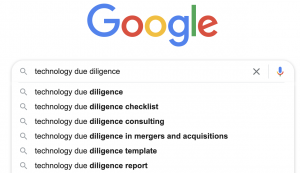Technology Due Diligence – convincing investors.
Technology spending is typically one of the high costs in any business. Therefore, performing technology due diligence during an investment deal makes sense.
But at the time of writing, most investors do not undertake technology due diligence. Many see it as an expensive ‘check box’ exercise.
Hence, you can find a tremendous amount of information aimed at Investors. Helping them understand the benefits of investing in technology due diligence. But little on the benefits for the target management team.
And for an overview of what they are interested in, you may find this article, Tech DD – What Do Investors Want? helpful.
For example, the well-established and regarded Global Private Equity report from Bain & Co. this year (2022) has an in-depth section asking (Investors) Is Your Tech Due Diligence Good Enough?
It’s an excellent report, with storytelling infused to ensure you are engaged and understand why technology DD is necessary today.
And not to be biassed towards one of the significant firms, here are other documents:
- From Deloitte outlining the key points and benefits of Tech DD for M&A deals.
- KPMG explains the most difficult area to form a clear image of is the value of the IT department?
- EY’s perspective on leading in the Digital Economy (hint: due diligence is necessary)
- IBM shows how they are transforming DD using Watson
- PWC provides videos putting the case forward:
The objective in listing these is to demonstrate a tiny amount of high-quality, well-presented material to support technology due diligence.
It did not take too long to find any of this material.
But all of this material is understandably investor-focused. Very little material exists for management – who will be part of and impacted by the diligence exercise.
In the meantime, people are not seeking methodologies or justifications for a Tech DD exercise. Instead, they are seeking checklists and templates:

Technology Due Diligence – convincing the CTO
If the investor has opted to run a Tech DD project, you will need to participate and provide the information and attend interviews as required.
The overhead can be overwhelming. Especially as all teams have a business to run.
So it is important to outline the benefits to you and the team. The assumption here is that your technology, team and processes will be reviewed as part of the project:
Rapid assessment
An external assessment of your environment will likely be quicker than if you tried running the same process internally.
An entire and detailed technology assessment is usually completed within a matter of weeks. Often CTOs report they are surprised so much can be gathered from in such little time.
Acknowledgement
External validation of the work you and your team have completed or in-flight has been helpful for some CTOs. Many find technology due diligence is a confirmation of how far they’ve progressed.
Challenge
Having your environment professionally challenged clarifies the robustness and technology environment’s ‘fit for purpose’. And there will be an assessment to determine if your tech will support the business growth plan. In the addition, collaborative challenge helps uncover new opportunities.
Backing
Technology practitioners will understand your challenges and balancing the needs of the business and the tech team.
Having people on your side to re-present an idea or initiative, which invariably needs more spending, helps provide the backing and resources for change.
This is a very common outcome in IT, Security and Software Development. The tech will be a new liability for the new owner without the additional investment.
Improvements
‘Auditing’ is of little value during these projects. More weight is added if external consultants help by combining their experience with the cross-pollination of working with hundreds of firms previously.
If acceptable to all parties, sharing ideas can be beneficial for all.
Benchmarking
The creativity in technology is like a blank canvas, where every firm builds and operates tech in its unique way. Hence, it isn’t easy to assess every firm against precisely the same criteria.
But evaluating the maturity of critical areas is possible, and this can be useful for you as a CTO to know what needs to change and where the strengths are in your team.
A useful skill
We notice the people who have been through IT Due Diligence previously as they arrive at the project fully prepared and can participate fully.
In addition, learning this skill provides perspective and a good entry point into acquisitions and investment.
One area that tends to be how to present the IT Budget in an investor-friendly format, and this can hold up the entire IT Due Diligence process.
So we published this articleWhat goes in an IT budget for Tech DD? to help management get this right, first time.
You may also have to tailor your approach and the information presented as suggested in this article The type of buyer impacts your Tech DD.
The best technology due diligence benefits all parties.
Most if not material regarding technology due diligence is aimed at the purse-strings holder, the investor.
They need to understand why it is beneficial to start the process in the first place.
But we also believe it can help the CTO as they go on to the next growth stage.







